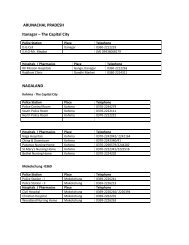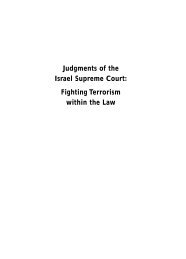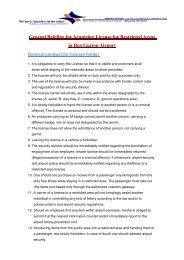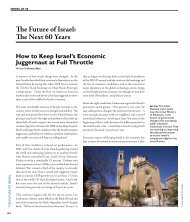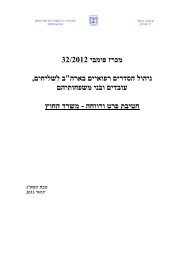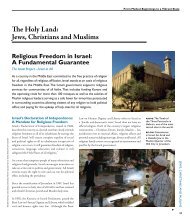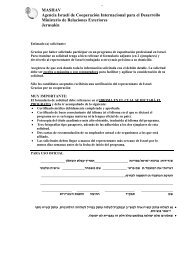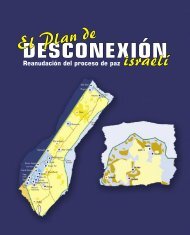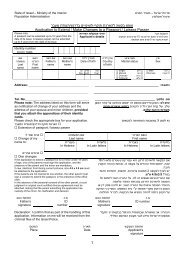Judgments of the Israel Supreme Court: Fighting Terrorism within ...
Judgments of the Israel Supreme Court: Fighting Terrorism within ...
Judgments of the Israel Supreme Court: Fighting Terrorism within ...
Create successful ePaper yourself
Turn your PDF publications into a flip-book with our unique Google optimized e-Paper software.
22. A number <strong>of</strong> residents <strong>of</strong> Mevasseret Zion, which is adjacent to <strong>the</strong> Beit<br />
Sourik village, requested to join as petitioners in this petition. They claim that<br />
<strong>the</strong> fence route should be immediately adjacent to <strong>the</strong> Green Line, in order to<br />
allow residents <strong>of</strong> <strong>the</strong> Beit Sourik village to work <strong>the</strong>ir land. In addition, <strong>the</strong>y<br />
claim that <strong>the</strong> gates which will allow <strong>the</strong> passage <strong>of</strong> farmers are inefficient,<br />
as <strong>the</strong>y will obstruct access to <strong>the</strong> fields, and <strong>the</strong>y will violate <strong>the</strong> farmers’<br />
dignity. Fur<strong>the</strong>rmore, <strong>the</strong>y point out <strong>the</strong> decline <strong>of</strong> relations between <strong>the</strong>m and<br />
<strong>the</strong> Palestinian population in <strong>the</strong> area which, as a consequence <strong>of</strong> <strong>the</strong> desire<br />
to construct <strong>the</strong> separation fence on <strong>the</strong>ir land, has turned from a tranquil<br />
population into a hostile one. On <strong>the</strong> opposing side, Mr. Efraim Halevy<br />
requested to join as a respondent in <strong>the</strong> petition. He argues that moving <strong>the</strong><br />
route <strong>of</strong> <strong>the</strong> fence adjacent to <strong>the</strong> Green Line will endanger <strong>the</strong> residents <strong>of</strong><br />
Mevasseret Zion. It will bring <strong>the</strong> route closer to <strong>the</strong> houses and schools in<br />
<strong>the</strong> community. He also points out <strong>the</strong> terrorist activity which has taken place<br />
in <strong>the</strong> past in <strong>the</strong> Beit Sourik area. Thus, <strong>the</strong> alternate route proposed by <strong>the</strong><br />
petitioners should be rejected. He claims that this position reflects <strong>the</strong> opinions<br />
<strong>of</strong> many residents <strong>of</strong> Mevasseret Zion. After reading <strong>the</strong> motions, we decided<br />
to accept <strong>the</strong>m, and we considered <strong>the</strong> arguments <strong>the</strong>y presented.<br />
The Normative Framework<br />
23. The general starting point <strong>of</strong> all parties – which is also our starting point<br />
– is that <strong>Israel</strong> holds <strong>the</strong> area in belligerent occupation (occupatio bellica).<br />
See HCJ 619/78 “El Tal’ia” Weekly v. Minister <strong>of</strong> Defense; HCJ 69/81 Abu<br />
Ita v. Commander <strong>of</strong> <strong>the</strong> Area <strong>of</strong> Judea and Samaria; HCJ 606/78 Ayoob v.<br />
Minister <strong>of</strong> Defense; HCJ 393/82 Jam'iat Ascan Elma’almoon Eltha’aooniah<br />
Elmahduda Elmaoolieh v. Commander <strong>of</strong> <strong>the</strong> IDF Forces in <strong>the</strong> Area <strong>of</strong> Judea<br />
and Samaria. In <strong>the</strong> areas relevant to this petition, <strong>the</strong> military administration,<br />
headed by <strong>the</strong> military commander, continues to apply. Compare HCJ 2717/<br />
96 Wafa v. Minister <strong>of</strong> Defense (application <strong>of</strong> <strong>the</strong> military administration in<br />
“Area C”). The authority <strong>of</strong> <strong>the</strong> military commander flows from <strong>the</strong> provisions<br />
<strong>of</strong> public international law regarding belligerent occupation. These rules are<br />
established principally in <strong>the</strong> Regulations Concerning <strong>the</strong> Laws and Customs<br />
<strong>of</strong> War on Land, The Hague, 18 October 1907 [hereinafter – <strong>the</strong> Hague<br />
Regulations]. These regulations reflect customary international law. The<br />
military commander’s authority is also anchored in IV Geneva Convention<br />
Relative to <strong>the</strong> Protection <strong>of</strong> Civilian Persons in Time <strong>of</strong> War 1949.<br />
[hereinafter – <strong>the</strong> Fourth Geneva Convention]. The question <strong>of</strong> <strong>the</strong> application<br />
<strong>of</strong> <strong>the</strong> Fourth Geneva Convention has come up more than once in this <strong>Court</strong>.<br />
24



